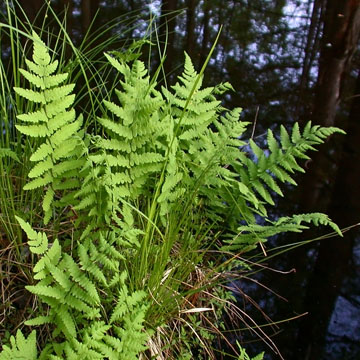

Thelypteris palustris - (image 1 of 4)
Taxonomy
Family: Thelypteridaceae
Plants in the northeastern U.S. are T. palustris Schott var. pubescens (G. Lawson) Fern. Synonymous with Dryopteris thelypteris (L.) Gray var. pubescens (G. Lawson) Nakai.
Habitat
Bogs, marshy ground, calcareous fens. Often in full sun.
Associates
Distribution
Widespread in the Northern Hemisphere.
Morphology
Deciduous fern from a mostly glabrous rhizome. Leaf blades 20 x 40 cm, lanceolate or lance-oblong, pinnate-pinnatifid, acuminate, only slightly narrowed at the base; leaf segments ciliate; rachis with acicular unicellular hairs above; petioles scaleless, glabrous, black at the base, petioles of sterile leaves to 35 cm, shorter of longer than the blades, those of the fertile leaves to 70 cm and longer than the blades; veins often forked. Sorus intermarginal, borne on a vein that continues to the margin, with a cilate or rarely glabrous indusium; indusium attached at one side of the sorus.
Notes
Spores early August to mid October
Wetland indicator: Obligate
This plant is relatively easy to grow from spores. Fronds can be collected in late fall or early winter, dried (if not crispy already), and the spores collected. Scattered over a moist medium and covered, the prothalli develop in 1-2 months. Fronds will develop after another 2 months or so and can be slowly acclimated to drier air and then transplanted into individual pots.
References
Gleason, Henry A. and A. Cronquist. 1991. Manual of Vascular Plants of Northeastern United States and Adjacent Canada. Second Ed.
The New York Botanical Garden. Bronx, NY
Swink, F. and G. Wilhelm. 1994. Plants of the Chicago Region.
Indiana Academy of Science. The Morton Arboretum. Lisle, Illinois.
|
Michael Hough © 2005 |